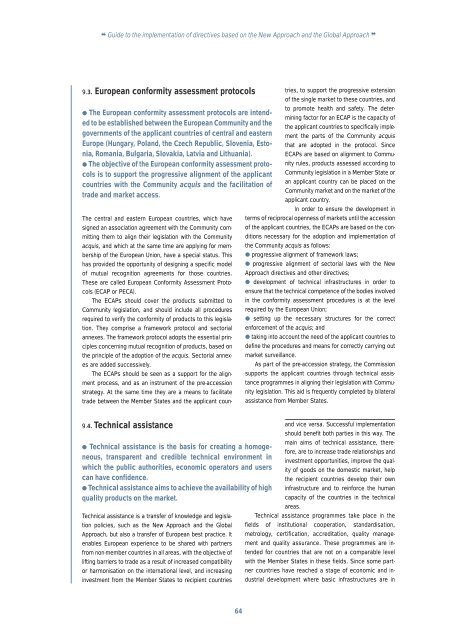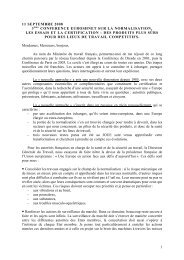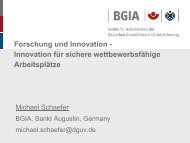Guide to the implementation of directives based on the New ...
Guide to the implementation of directives based on the New ...
Guide to the implementation of directives based on the New ...
You also want an ePaper? Increase the reach of your titles
YUMPU automatically turns print PDFs into web optimized ePapers that Google loves.
❝ <str<strong>on</strong>g>Guide</str<strong>on</strong>g> <str<strong>on</strong>g>to</str<strong>on</strong>g> <str<strong>on</strong>g>the</str<strong>on</strong>g> <str<strong>on</strong>g>implementati<strong>on</strong></str<strong>on</strong>g> <str<strong>on</strong>g>of</str<strong>on</strong>g> <str<strong>on</strong>g>directives</str<strong>on</strong>g> <str<strong>on</strong>g>based</str<strong>on</strong>g> <strong>on</strong> <str<strong>on</strong>g>the</str<strong>on</strong>g> <strong>New</strong> Approach and <str<strong>on</strong>g>the</str<strong>on</strong>g> Global Approach ❞<br />
9.3. European c<strong>on</strong>formity assessment pro<str<strong>on</strong>g>to</str<strong>on</strong>g>cols<br />
tries, <str<strong>on</strong>g>to</str<strong>on</strong>g> support <str<strong>on</strong>g>the</str<strong>on</strong>g> progressive extensi<strong>on</strong><br />
<str<strong>on</strong>g>of</str<strong>on</strong>g> <str<strong>on</strong>g>the</str<strong>on</strong>g> single market <str<strong>on</strong>g>to</str<strong>on</strong>g> <str<strong>on</strong>g>the</str<strong>on</strong>g>se countries, and<br />
<str<strong>on</strong>g>to</str<strong>on</strong>g> promote health and safety. The determining<br />
fac<str<strong>on</strong>g>to</str<strong>on</strong>g>r for an ECAP is <str<strong>on</strong>g>the</str<strong>on</strong>g> capacity <str<strong>on</strong>g>of</str<strong>on</strong>g><br />
● The European c<strong>on</strong>formity assessment pro<str<strong>on</strong>g>to</str<strong>on</strong>g>cols are intended<br />
<str<strong>on</strong>g>to</str<strong>on</strong>g> be established between <str<strong>on</strong>g>the</str<strong>on</strong>g> European Community and <str<strong>on</strong>g>the</str<strong>on</strong>g><br />
<str<strong>on</strong>g>the</str<strong>on</strong>g> applicant countries <str<strong>on</strong>g>to</str<strong>on</strong>g> specifically implement<br />
<str<strong>on</strong>g>the</str<strong>on</strong>g> parts <str<strong>on</strong>g>of</str<strong>on</strong>g> <str<strong>on</strong>g>the</str<strong>on</strong>g> Community acquis<br />
governments <str<strong>on</strong>g>of</str<strong>on</strong>g> <str<strong>on</strong>g>the</str<strong>on</strong>g> applicant countries <str<strong>on</strong>g>of</str<strong>on</strong>g> central and eastern<br />
Europe (Hungary, Poland, <str<strong>on</strong>g>the</str<strong>on</strong>g> Czech Republic, Slovenia, Es<str<strong>on</strong>g>to</str<strong>on</strong>g>nia,<br />
Romania, Bulgaria, Slovakia, Latvia and Lithuania).<br />
ECAPs are <str<strong>on</strong>g>based</str<strong>on</strong>g> <strong>on</strong> alignment <str<strong>on</strong>g>to</str<strong>on</strong>g> Commu-<br />
that are adopted in <str<strong>on</strong>g>the</str<strong>on</strong>g> pro<str<strong>on</strong>g>to</str<strong>on</strong>g>col. Since<br />
● The objective <str<strong>on</strong>g>of</str<strong>on</strong>g> <str<strong>on</strong>g>the</str<strong>on</strong>g> European c<strong>on</strong>formity assessment pro<str<strong>on</strong>g>to</str<strong>on</strong>g>cols<br />
is <str<strong>on</strong>g>to</str<strong>on</strong>g> support <str<strong>on</strong>g>the</str<strong>on</strong>g> progressive alignment <str<strong>on</strong>g>of</str<strong>on</strong>g> <str<strong>on</strong>g>the</str<strong>on</strong>g> applicant Community legislati<strong>on</strong> in a Member State or<br />
nity rules, products assessed according <str<strong>on</strong>g>to</str<strong>on</strong>g><br />
an applicant country can be placed <strong>on</strong> <str<strong>on</strong>g>the</str<strong>on</strong>g><br />
countries with <str<strong>on</strong>g>the</str<strong>on</strong>g> Community acquis and <str<strong>on</strong>g>the</str<strong>on</strong>g> facilitati<strong>on</strong> <str<strong>on</strong>g>of</str<strong>on</strong>g><br />
Community market and <strong>on</strong> <str<strong>on</strong>g>the</str<strong>on</strong>g> market <str<strong>on</strong>g>of</str<strong>on</strong>g> <str<strong>on</strong>g>the</str<strong>on</strong>g><br />
trade and market access.<br />
applicant country.<br />
In order <str<strong>on</strong>g>to</str<strong>on</strong>g> ensure <str<strong>on</strong>g>the</str<strong>on</strong>g> development in<br />
The central and eastern European countries, which have terms <str<strong>on</strong>g>of</str<strong>on</strong>g> reciprocal openness <str<strong>on</strong>g>of</str<strong>on</strong>g> markets until <str<strong>on</strong>g>the</str<strong>on</strong>g> accessi<strong>on</strong><br />
signed an associati<strong>on</strong> agreement with <str<strong>on</strong>g>the</str<strong>on</strong>g> Community committing<br />
<str<strong>on</strong>g>the</str<strong>on</strong>g>m <str<strong>on</strong>g>to</str<strong>on</strong>g> align <str<strong>on</strong>g>the</str<strong>on</strong>g>ir legislati<strong>on</strong> with <str<strong>on</strong>g>the</str<strong>on</strong>g> Community diti<strong>on</strong>s necessary for <str<strong>on</strong>g>the</str<strong>on</strong>g> adopti<strong>on</strong> and <str<strong>on</strong>g>implementati<strong>on</strong></str<strong>on</strong>g> <str<strong>on</strong>g>of</str<strong>on</strong>g><br />
<str<strong>on</strong>g>of</str<strong>on</strong>g> <str<strong>on</strong>g>the</str<strong>on</strong>g> applicant countries, <str<strong>on</strong>g>the</str<strong>on</strong>g> ECAPs are <str<strong>on</strong>g>based</str<strong>on</strong>g> <strong>on</strong> <str<strong>on</strong>g>the</str<strong>on</strong>g> c<strong>on</strong>-<br />
acquis, and which at <str<strong>on</strong>g>the</str<strong>on</strong>g> same time are applying for membership<br />
<str<strong>on</strong>g>of</str<strong>on</strong>g> <str<strong>on</strong>g>the</str<strong>on</strong>g> European Uni<strong>on</strong>, have a special status. This ● progressive alignment <str<strong>on</strong>g>of</str<strong>on</strong>g> framework laws;<br />
<str<strong>on</strong>g>the</str<strong>on</strong>g> Community acquis as follows:<br />
has provided <str<strong>on</strong>g>the</str<strong>on</strong>g> opportunity <str<strong>on</strong>g>of</str<strong>on</strong>g> designing a specific model ● progressive alignment <str<strong>on</strong>g>of</str<strong>on</strong>g> sec<str<strong>on</strong>g>to</str<strong>on</strong>g>rial laws with <str<strong>on</strong>g>the</str<strong>on</strong>g> <strong>New</strong><br />
<str<strong>on</strong>g>of</str<strong>on</strong>g> mutual recogniti<strong>on</strong> agreements for those countries. Approach <str<strong>on</strong>g>directives</str<strong>on</strong>g> and o<str<strong>on</strong>g>the</str<strong>on</strong>g>r <str<strong>on</strong>g>directives</str<strong>on</strong>g>;<br />
These are called European C<strong>on</strong>formity Assessment Pro<str<strong>on</strong>g>to</str<strong>on</strong>g>cols<br />
(ECAP or PECA).<br />
ensure that <str<strong>on</strong>g>the</str<strong>on</strong>g> technical competence <str<strong>on</strong>g>of</str<strong>on</strong>g> <str<strong>on</strong>g>the</str<strong>on</strong>g> bodies involved<br />
● development <str<strong>on</strong>g>of</str<strong>on</strong>g> technical infrastructures in order <str<strong>on</strong>g>to</str<strong>on</strong>g><br />
The ECAPs should cover <str<strong>on</strong>g>the</str<strong>on</strong>g> products submitted <str<strong>on</strong>g>to</str<strong>on</strong>g> in <str<strong>on</strong>g>the</str<strong>on</strong>g> c<strong>on</strong>formity assessment procedures is at <str<strong>on</strong>g>the</str<strong>on</strong>g> level<br />
Community legislati<strong>on</strong>, and should include all procedures required by <str<strong>on</strong>g>the</str<strong>on</strong>g> European Uni<strong>on</strong>;<br />
required <str<strong>on</strong>g>to</str<strong>on</strong>g> verify <str<strong>on</strong>g>the</str<strong>on</strong>g> c<strong>on</strong>formity <str<strong>on</strong>g>of</str<strong>on</strong>g> products <str<strong>on</strong>g>to</str<strong>on</strong>g> this legislati<strong>on</strong>.<br />
They comprise a framework pro<str<strong>on</strong>g>to</str<strong>on</strong>g>col and sec<str<strong>on</strong>g>to</str<strong>on</strong>g>rial enforcement <str<strong>on</strong>g>of</str<strong>on</strong>g> <str<strong>on</strong>g>the</str<strong>on</strong>g> acquis; and<br />
● setting up <str<strong>on</strong>g>the</str<strong>on</strong>g> necessary structures for <str<strong>on</strong>g>the</str<strong>on</strong>g> correct<br />
annexes. The framework pro<str<strong>on</strong>g>to</str<strong>on</strong>g>col adopts <str<strong>on</strong>g>the</str<strong>on</strong>g> essential principles<br />
c<strong>on</strong>cerning mutual recogniti<strong>on</strong> <str<strong>on</strong>g>of</str<strong>on</strong>g> products, <str<strong>on</strong>g>based</str<strong>on</strong>g> <strong>on</strong> define <str<strong>on</strong>g>the</str<strong>on</strong>g> procedures and means for correctly carrying out<br />
● taking in<str<strong>on</strong>g>to</str<strong>on</strong>g> account <str<strong>on</strong>g>the</str<strong>on</strong>g> need <str<strong>on</strong>g>of</str<strong>on</strong>g> <str<strong>on</strong>g>the</str<strong>on</strong>g> applicant countries <str<strong>on</strong>g>to</str<strong>on</strong>g><br />
<str<strong>on</strong>g>the</str<strong>on</strong>g> principle <str<strong>on</strong>g>of</str<strong>on</strong>g> <str<strong>on</strong>g>the</str<strong>on</strong>g> adopti<strong>on</strong> <str<strong>on</strong>g>of</str<strong>on</strong>g> <str<strong>on</strong>g>the</str<strong>on</strong>g> acquis. Sec<str<strong>on</strong>g>to</str<strong>on</strong>g>rial annexes<br />
are added successively.<br />
As part <str<strong>on</strong>g>of</str<strong>on</strong>g> <str<strong>on</strong>g>the</str<strong>on</strong>g> pre-accessi<strong>on</strong> strategy, <str<strong>on</strong>g>the</str<strong>on</strong>g> Commissi<strong>on</strong><br />
market surveillance.<br />
The ECAPs should be seen as a support for <str<strong>on</strong>g>the</str<strong>on</strong>g> alignment<br />
process, and as an instrument <str<strong>on</strong>g>of</str<strong>on</strong>g> <str<strong>on</strong>g>the</str<strong>on</strong>g> pre-accessi<strong>on</strong> tance programmes in aligning <str<strong>on</strong>g>the</str<strong>on</strong>g>ir legislati<strong>on</strong> with Commu-<br />
supports <str<strong>on</strong>g>the</str<strong>on</strong>g> applicant countries through technical assis-<br />
strategy. At <str<strong>on</strong>g>the</str<strong>on</strong>g> same time <str<strong>on</strong>g>the</str<strong>on</strong>g>y are a means <str<strong>on</strong>g>to</str<strong>on</strong>g> facilitate nity legislati<strong>on</strong>. This aid is frequently completed by bilateral<br />
trade between <str<strong>on</strong>g>the</str<strong>on</strong>g> Member States and <str<strong>on</strong>g>the</str<strong>on</strong>g> applicant coun-<br />
assistance from Member States.<br />
and vice versa. Successful <str<strong>on</strong>g>implementati<strong>on</strong></str<strong>on</strong>g><br />
should benefit both parties in this way. The<br />
main aims <str<strong>on</strong>g>of</str<strong>on</strong>g> technical assistance, <str<strong>on</strong>g>the</str<strong>on</strong>g>refore,<br />
are <str<strong>on</strong>g>to</str<strong>on</strong>g> increase trade relati<strong>on</strong>ships and<br />
● Technical assistance is <str<strong>on</strong>g>the</str<strong>on</strong>g> basis for creating a homogeneous,<br />
transparent and credible technical envir<strong>on</strong>ment in<br />
investment opportunities, improve <str<strong>on</strong>g>the</str<strong>on</strong>g> quality<br />
<str<strong>on</strong>g>of</str<strong>on</strong>g> goods <strong>on</strong> <str<strong>on</strong>g>the</str<strong>on</strong>g> domestic market, help<br />
which <str<strong>on</strong>g>the</str<strong>on</strong>g> public authorities, ec<strong>on</strong>omic opera<str<strong>on</strong>g>to</str<strong>on</strong>g>rs and users<br />
can have c<strong>on</strong>fidence.<br />
● Technical assistance aims <str<strong>on</strong>g>to</str<strong>on</strong>g> achieve <str<strong>on</strong>g>the</str<strong>on</strong>g> availability <str<strong>on</strong>g>of</str<strong>on</strong>g> high<br />
quality products <strong>on</strong> <str<strong>on</strong>g>the</str<strong>on</strong>g> market.<br />
<str<strong>on</strong>g>the</str<strong>on</strong>g> recipient countries develop <str<strong>on</strong>g>the</str<strong>on</strong>g>ir own<br />
infrastructure and <str<strong>on</strong>g>to</str<strong>on</strong>g> reinforce <str<strong>on</strong>g>the</str<strong>on</strong>g> human<br />
capacity <str<strong>on</strong>g>of</str<strong>on</strong>g> <str<strong>on</strong>g>the</str<strong>on</strong>g> countries in <str<strong>on</strong>g>the</str<strong>on</strong>g> technical<br />
areas.<br />
Technical assistance is a transfer <str<strong>on</strong>g>of</str<strong>on</strong>g> knowledge and legislati<strong>on</strong><br />
Technical assistance programmes take place in <str<strong>on</strong>g>the</str<strong>on</strong>g><br />
policies, such as <str<strong>on</strong>g>the</str<strong>on</strong>g> <strong>New</strong> Approach and <str<strong>on</strong>g>the</str<strong>on</strong>g> Global fields <str<strong>on</strong>g>of</str<strong>on</strong>g> instituti<strong>on</strong>al cooperati<strong>on</strong>, standardisati<strong>on</strong>,<br />
Approach, but also a transfer <str<strong>on</strong>g>of</str<strong>on</strong>g> European best practice. It<br />
enables European experience <str<strong>on</strong>g>to</str<strong>on</strong>g> be shared with partners<br />
from n<strong>on</strong>-member countries in all areas, with <str<strong>on</strong>g>the</str<strong>on</strong>g> objective <str<strong>on</strong>g>of</str<strong>on</strong>g><br />
lifting barriers <str<strong>on</strong>g>to</str<strong>on</strong>g> trade as a result <str<strong>on</strong>g>of</str<strong>on</strong>g> increased compatibility<br />
or harm<strong>on</strong>isati<strong>on</strong> <strong>on</strong> <str<strong>on</strong>g>the</str<strong>on</strong>g> internati<strong>on</strong>al level, and increasing<br />
investment from <str<strong>on</strong>g>the</str<strong>on</strong>g> Member States <str<strong>on</strong>g>to</str<strong>on</strong>g> recipient countries<br />
metrology, certificati<strong>on</strong>, accreditati<strong>on</strong>, quality management<br />
and quality assurance. These programmes are intended<br />
for countries that are not <strong>on</strong> a comparable level<br />
with <str<strong>on</strong>g>the</str<strong>on</strong>g> Member States in <str<strong>on</strong>g>the</str<strong>on</strong>g>se fields. Since some partner<br />
countries have reached a stage <str<strong>on</strong>g>of</str<strong>on</strong>g> ec<strong>on</strong>omic and industrial<br />
development where basic infrastructures are in<br />
9.4. Technical assistance<br />
64




